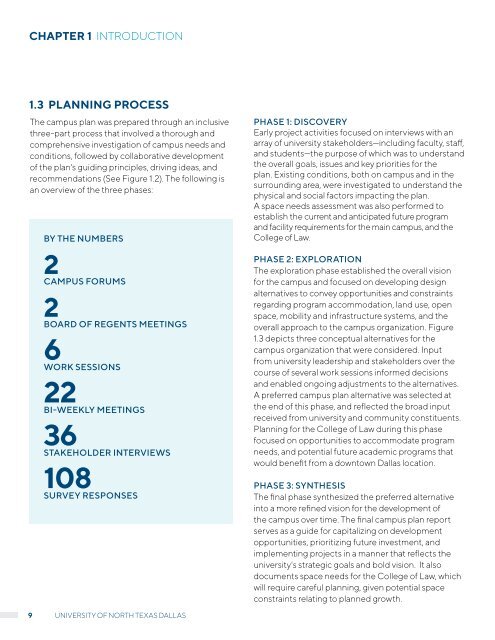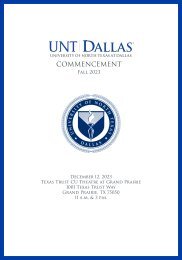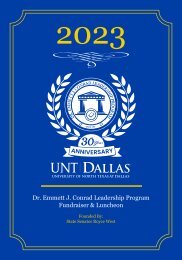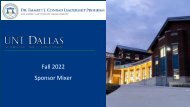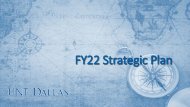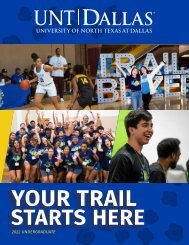UNT Dallas 2020 Master Plan
Create successful ePaper yourself
Turn your PDF publications into a flip-book with our unique Google optimized e-Paper software.
CHAPTER 1 INTRODUCTION<br />
1.3 PLANNING PROCESS<br />
The campus plan was prepared through an inclusive<br />
three-part process that involved a thorough and<br />
comprehensive investigation of campus needs and<br />
conditions, followed by collaborative development<br />
of the plan's guiding principles, driving ideas, and<br />
recommendations (See Figure 1.2). The following is<br />
an overview of the three phases:<br />
BY THE NUMBERS<br />
2CAMPUS FORUMS<br />
2BOARD OF REGENTS MEETINGS<br />
6WORK SESSIONS<br />
22<br />
BI-WEEKLY MEETINGS<br />
36<br />
STAKEHOLDER INTERVIEWS<br />
108<br />
SURVEY RESPONSES<br />
PHASE 1: DISCOVERY<br />
Early project activities focused on interviews with an<br />
array of university stakeholders—including faculty, staff,<br />
and students—the purpose of which was to understand<br />
the overall goals, issues and key priorities for the<br />
plan. Existing conditions, both on campus and in the<br />
surrounding area, were investigated to understand the<br />
physical and social factors impacting the plan.<br />
A space needs assessment was also performed to<br />
establish the current and anticipated future program<br />
and facility requirements for the main campus, and the<br />
College of Law.<br />
PHASE 2: EXPLORATION<br />
The exploration phase established the overall vision<br />
for the campus and focused on developing design<br />
alternatives to convey opportunities and constraints<br />
regarding program accommodation, land use, open<br />
space, mobility and infrastructure systems, and the<br />
overall approach to the campus organization. Figure<br />
1.3 depicts three conceptual alternatives for the<br />
campus organization that were considered. Input<br />
from university leadership and stakeholders over the<br />
course of several work sessions informed decisions<br />
and enabled ongoing adjustments to the alternatives.<br />
A preferred campus plan alternative was selected at<br />
the end of this phase, and reflected the broad input<br />
received from university and community constituents.<br />
<strong>Plan</strong>ning for the College of Law during this phase<br />
focused on opportunities to accommodate program<br />
needs, and potential future academic programs that<br />
would benefit from a downtown <strong>Dallas</strong> location.<br />
PHASE 3: SYNTHESIS<br />
The final phase synthesized the preferred alternative<br />
into a more refined vision for the development of<br />
the campus over time. The final campus plan report<br />
serves as a guide for capitalizing on development<br />
opportunities, prioritizing future investment, and<br />
implementing projects in a manner that reflects the<br />
university's strategic goals and bold vision. It also<br />
documents space needs for the College of Law, which<br />
will require careful planning, given potential space<br />
constraints relating to planned growth.<br />
9<br />
UNIVERSITY OF NORTH TEXAS DALLAS


